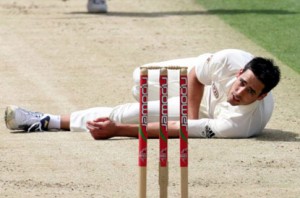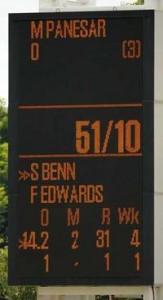
A gradual but inevitable descent into cricket-based loathing and bile.
An In The Air! And Safe! And Out! Special: Introducing Steve Smith International Cricket
As strange as it might seem, there was once a time when the video-game market was devoid of good football titles. There were a bunch of games out there that gamers at the time thought were ok, but in reality were pretty crap (and yes, we include Sensible Soccer in that). Then, in short succession, along came FIFA and Pro Evo, and the genre was changed forever. Cricket games have never had that epoch changing moment, when one game has come along and rendered all previous efforts as redundant. Until now that is.
During the course of our ongoing ‘In The Air! And Safe! And Out!’ series, we’ve become so incensed at the lack of vision, ambition or sheer competence shown by cricket game developers that we put our collective heads together and came up with what, in our minds, would be the greatest cricket game ever made. Reasonably enough headed by possibly the world’s greatest cricketer.
Of course, collectively the 51allout team barely possesses the ability to programme a DVD player, let alone put together a complete video game, but we think you’ll agree that the below suggestions would, if they ever saw the light of day, blow anything currently on the market out of the water. And who knows, if we get enough positive feedback we might just be encouraged enough to chuck together a Kickstarter project to con people out of their money.
Introducing Steve Smith International Cricket (Wii, PS3, Xbox 360, SNES, Atari 5200, ColecoVision, Virtual Boy)

Yes, we are re-using the image from the title, but it’s so bloody brilliant we think we can be excused.
Control scheme
As we’ve repeatedly pointed out in past reviews, we think most cricket games give an appallingly limited scope of control to the player, often one that barely does justice to the intricacies of batting in particular. So this is as good as place to start as any. Most controllers these days have two analogue sticks, so we might as well make use of them. The right stick controls the shot the batsman is to play, push forward to drive, back for block, right for cut etc. So far so predictable. The left stick, however, can be used to control the bat face. So for a right handed batsman, pushing left will open the face, right will close the face. Pulling back or forward will add loft or play the shot along the ground.
With that simple change already the scope of possible strokes is increased enormously. Plus it adds a further tactical element to the game. If the opposition is moving the new ball about all over the place do you play with an open face or closed? The right and left triggers can be used for the traditional ‘slog’ shot and to leave the ball. It’s a simple method of giving the player more control over the batsman, and thereby immersing the player in the game, particularly when it’s coupled with the next change.
Get rid of cursors
You know those cursors you move around the pitch to pick the exact point you want to bowl? Get rid of them. Completely. Moving a cursor around isn’t fun for the bowler, and makes batting utterly tedious. In our game we envision bowling working rather similarly to how it does in the International Cricket Captain series, in that you choose a line, a length, and an aggression setting for your bowler, with no tedious mucking about each ball. You will be given scope to change things up from there, trying for yorkers or bouncers and the like, but the more variations you attempt the worse your bowlers control will be, depending on their ability. Bowling is about following a plan after all (unless you’re Mitchell Johnson) and the player ought to be rewarded for setting one and persisting with it.
How batting would work in this scenario is tricky, but it would be based on being able to watch the ball out of the bowler’s hand in order to pick up the length early, you know, like how it happens in real life, probably by bringing the camera right down to the batsman’s eye-line (a theme we’ll discuss more in the next point). Ideally this would work out that when facing express bowlers, you as the batsman ought to be edge of your seat trying to react in time, not just watching some cursor on the pitch and preparing way ahead of time. Batting ought to be about concentration and shot selection, again as it is in reality, and by forcing the player to watch every delivery closely, those qualities will be rewarded, whilst pre-empting shots will quickly become a minefield.
Dump the TV style presentation
The standard across all sports games is to present them as if you were sitting at home and watching a real game. That’s fine for fast paced games, but for something like cricket it quickly drags everything out and becomes tedious. The little cutaways of the bowler walking back to his mark, the umpire signalling, shots of the scoreboard etc. can be dumped entirely. The action ought to be quick, so each delivery begins with the bowler already on his way in and with no needless diversions inbetween.
The streamlined bowling mechanics, as well as the changes to fielding that we’ll cover below, will mean that each over ought to be a fast paced affair and, as a result, the player should be able to play a full game in a reasonable length of time. Which is the real goal here, as a game that is only really enjoyable in 10 or 20 over innings is a bit of a waste.
Make fielding fun
Admittedly we’re a little unsure of how to go about this, but the fact stands that in every cricket game to date, fielding has been an utter pain in the arse. Directing an appallingly slow fieldsmen around whilst the ball flies away to the boundary is worse entertainment than last season’s Friends Life T20 tournament. Our initial idea was to make fielding entirely automatic, and the efficiency of fielders scooping up the ball and returning it or pulling off diving catches to be determined via quick time events.
However since quick time events are loathed by everyone, except Japanese game designers who love to throw them in wherever they can, we’re not completely convinced. However, one thing we are sure of is how the fielding team sets their field. Fields ought to be preset for each batsman before the game begins, as part of the bowling plan that we touched on earlier. From there it would be a simple matter of having pre-built changes already set. Press up on the D-Pad to bring in another slip, or a short-leg, for instance. The idea, again, is to cut out the mucking about and make sure the gameplay is quick in order that games can be completed in a reasonable amount of time.
Stats. And lots of them
If there’s one thing cricket is really good at it’s generating mountains of statistics. And fans of the game typically lap them up. So it goes without saying that a game devoted to the sport also ought to be able to generate and keep track of a mountain of statistics as the game progresses.
It’s something that baseball games have been aware of and have taken advantage of for some time now and, like in everything else, cricket games have lagged behind badly. But after Steve Smith International Cricket, no more.
An exhaustive career mode
One of the major advances in recent versions of FIFA is how they have managed to make the player feel like they are part of a larger world of football (otherwise, yes, the games are otherwise essentially identical). The same concept could easily be applied to a cricket game, where not only do you play the game, but are also responsible for off-field matters as well, like player development.
Of course, we say easily applied because we would have no intention of doing the hard work ourselves, but instead would rip that component of the game straight out of the International Cricket Captain series, which already has a fully functioning, and more importantly, believable, simulation of the world of cricket up and running. We imagine we could pay for the rights from Childish Things in empty Kingfisher beer bottles or something (seriously Kingfisher: send more beer).
So there you have it. The greatest cricket game never made. If you have any further suggestions, or even criticisms, feel free to add them below. Of course if you want to throw stupid amounts of money at us as well that’s fine by us too. We just can’t guarantee we’ll spend the money on actually making the game.




4 Comments
Post a Comment
1
Matt Larnach
04 Dec 2012 00:55
That would work well, especially since all the next gen consoles will come out with copycat tablet controllers in the next year as well.
Plus it will give us something to play on the office Wii U other than NintendoLand.
2
Alex
03 Dec 2012 19:28
I’m going to make an almost sensible, fairly topical suggestion. The reason the cursor position to bowl approach doesn’t work well is because both players i.e. batsman and bowler know near enough where the ball will land and gives the batsman the opportunity to plan ahead.
With the Wii U now out, and the opportunity for dual screens, could this be used to give a better control method, with the batsman using the TV screen view to watch the ball out of the hand, and the bowler using the tablet controller to use the cursor approach to land the ball, etc, without the batsman getting a look in?
On a less serious note, wasn’t Ian Botham’s cricket on the C64 great? I know, I’ll get my bowler to chuck down a spinning bouncer, that’ll fox the batsman!
3
Matt Larnach
02 Dec 2012 22:57
Hmm, that would require a sledging stat to be included. Something like Edo Brandes – 10, Glenn McGrath – 1. That could work.
4
Dom
02 Dec 2012 17:01
How about introducing a sledging function. If I’m controlling Dean Elgar and have played and missed at a Dale Steyn out swinger for the 11th time, I want to be told audibly by a virtual Steyn how much of a see you next Tuesday I am.
I then propose the “select” button can open up a menu of retorts: for example: “Smile Sarcastically” “Make profanity about sexual encounter with bowler’s sister” “Re-take guard” etc. All of which can positively or adversely affect said batsman’s confidence. Thoughts?